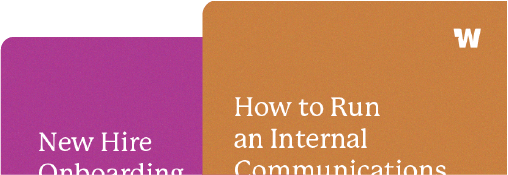How to manage change for frontline employees

Driving change across a frontline workforce is often a particularly challenging problem. If you have the last two pieces in place — a reliable way to reach them, and a more engaged group of employees — you’ll have a solid foundation for successful change management.
We’re with the original Harvard Business Review article: work closely and train your frontline managers. However, we depart a bit on the way you should bring frontline managers into the fold.
HBR recommends that employees hear big news from their frontline managers first. We tend to believe that this makes the supervisor the “fall guy”. However, supervisors should be a key part of forming the change management and subsequent communications strategy; we’ve done this most successfully by taking more of a cascading approach.
Here’s how we think about rolling out large-scale changes:
- Senior leadership is the first to know.
- Department heads are brought in next.
- Recruit a ‘core team’ to craft the communications strategy, messaging, and materials. This is best accomplished as a representative group from within the company, not strictly senior leaders (and this is where a lot of companies will go wrong). You want to bring in champions and captains from across the organization. These will ideally be individuals who are in the thick of the work but can also understand and believe in the bigger picture, and individuals who have great influence and respect among their peers. Make sure you have different departments, roles, levels, backgrounds, and optimize for a diversity of opinions.
- Build your plan. It doesn’t need to be 100% perfect, and will likely change during subsequent rounds of feedback, but try to get it to 70-80%. Here’s a very basic outline for a change management plan to get you started.
- Share it with middle managers and direct supervisors. Get their feedback on what the core team has already put together. Any earlier than this and you tend to get a massive mix of opinions that are all over the place; this at least gives you a plan that they can direct their feedback towards, and not simply an open call for ideas.
- Build your materials with the core team and bring in any needed production artists or creative resources. Incorporate any meaningful feedback from middle managers and direct supervisors. Recruit the marketing, HR, or communications professionals you need within the organization to create videos, infographics, emails, etc.
- Share all materials with the core team. I typically only offer one round of edits…usually, time is of the essence.
- Share all materials with leaders and managers. Give them all of the tools, FAQs, and materials they need to handle questions and concerns from their team in advance.
- Announce the change internally. We typically recommend doing this via a live all-company meeting for each office location or continent, though you could do it by department. The reason for this approach, rather than rolling it out via supervisors, is that we do believe that hearing change directly from the CEO prevents the frontline manager from being that “fall guy,” and adds weight, context, and vision to the announcement. It’s important that every employee sees the change as a part of a larger picture, and it’s crucial that they are all hearing the same narrative. (Usually, you’ll want to do this via a well-rehearsed and engaging presentation.)
- Immediately follow the announcement with small-group discussions and one-on-ones. This is where your supervisors are absolutely crucial. You’ve set them up as the “soft catch,” and by now, you’ve also given them any needed messages and materials they need to inform their team. They can tackle FAQs and tailor the announcement follow-ups appropriately. They’ve hopefully thought through which employees may support the change, and which ones may take issue with it. Plus, they knew about the news before the launch, so you’ve likely worked through any potential concerns of their own and have been able to get them more bought-in to the change in the first place.
- Provide all frontline employees with the materials they need for the public announcement. If your support team is going to be fielding questions from customers, make sure they have those FAQs in hand. If your communications team will be bombarded with questions from the press, make sure they’ve got their talking points ready to roll. If your HR team will need to handle a bunch of severance packages, be sure they’re prepared with the right documentation. Don’t leave your team scrambling to create all of these items last second.
- Announce the change publicly. We recommend that it goes to your customers/stakeholders first, and the general public second. For some reason, this doesn’t always happen in this order. You don’t want your employees to find out about the news from a press release, and you don’t want your customers to find out about it from your employees. Make sure you have the proper expectations and embargoes in place to control the flow of announcements in a really intentional way.
Of course, all of this assumes you know about the change well in advance and have the time to properly prepare for it; if you’re managing more of a crisis communications situation, you may have to take shortcuts or issue pre-prepared holding statements while you can get all of the above in place.
Once the change is communicated to all employees, remember that the work isn’t over. Make sure that your frontline supervisors continue to ask questions and get feedback from the team in one-on-ones.
We typically also recommend that you put together a debrief with the core team once enough time has passed, so that you can document your results and improve processes and strategies in the future.
This article is part of a larger guide, “Reaching, Engaging, and Changing Frontline Employees.” Download the full guide here, or click through the blog post series.
Previous blog posts: Reaching frontline employees and Engaging frontline employees
If you need assistance managing your communications strategy in the midst of a large company change, we’re here to help. Not only is Workshop a great solution for everyday communications with frontline employees, but you can use it to create an internally-focused command center and single source of truth during times of uncertainty. It’s the perfect solution for planning, publishing, and measuring your communications across multiple channels (email, text, Slack, your corporate intranet), all from one place.
Learn more about Workshop and contact us here!







